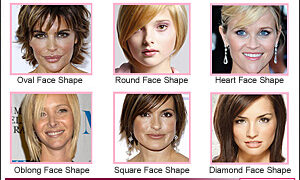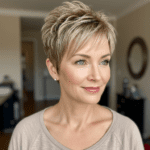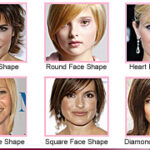The first step to getting a great hairstyle is finding the right hairstyle for your face shape.
Why is this so important? Simply put, if the wrong hairstyle is created for the wrong face shape, the result is a disaster. Even a well cut hairstyle on the wrong face shape, the result is still a disaster.
Hairstyles are predominately about shape and geometry. It’s all about putting the perfect frame around a person’s face to balance and bring perspective to the overall shape.
The shape must:
- Minimize non pleasing attributes.
- Promote and compliment positive ones.
Once this objective is achieved, then bringing the hairstyle to life with texture and colors should follow.
There is a general rule that applies to face shape balancing and it is that you should try to achieve an oval shape, which is the most perfect and pleasing shape to the human eye. To do this, long faces need shortening, just as wide faces need lengthening.
How to Determine Your Face Shape
Before selecting a hairstyle, you need to identify your face shape. Here’s a simple method:Compare your observations with the characteristics below
1. Pull your hair back completely from your face
2. Stand in front of a mirror with good lighting
3. Trace the outline of your face on the mirror with a washable marker (or just observe carefully)
4. Note the width of your forehead, cheekbones, and jawline
5. Observe the length of your face and the shape of your jaw
Oval Face Shape

- Curvilinear shape.
- Length is equal to one and a half times width.
- Your face is widest at your cheekbones.
- The forehead and jaw are approximately the same width.
- Your chin is rounded in shape with no hard lines.
- Your jawline has a slight roundness to it.
Round Face Shape
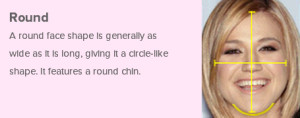
- Length is approximately equal to width.
- Your face is widest at your cheekbones.
- Your forehead and jawline are approximately the same width.
- Your chin is rounded in shape with no hard lines or angles.
- Your jawline is round and full in shape.
- Your forehead is wide and round at your hairline.
Best Hairstyles: - Layered cuts that add height at the crown
- Side parts to create asymmetry
- Long bobs (lobs) that fall below the chin
- Long layers with face-framing pieces
- Pixie cuts with volume on top
Styles to Avoid: - Chin-length bobs that emphasize roundness
- Blunt bangs that create a horizontal line
- Very short layers around the cheeks
Square Face Shape
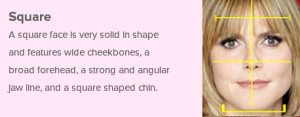
- Strong and broad forehead.
- Your face is approximately equal in regards to length and width.
- Your forehead and jawline are a similar width in appearance.
- Your chin is noticeably square and/or flat.
- Your cheeks and the sides of your face are straight.
- Your chin is noticeably square and/or flat.
Best Hairstyles: - Almost any style works well
- Medium-length cuts with layers
- Side-swept bangs
- Pixie cuts
- Shoulder-length bobs
Styles to Avoid: - Very bulky styles that add too much height
- Very long and straight styles without layers
Heart Face Shape

- Wide at the forehead and cheekbones.
- Your forehead and jawline are a similar width in appearance.
- Your chin is noticeably pointed.
- Your cheek line and the sides of your face taper into your jawline.
- Your forehead is wide and round at your hairline.
- Narrow at the jawline.
Best Hairstyles: - Chin-length or longer styles
- Side-swept bangs
- Layered mid-length cuts
- Wavy or curly styles that add width at the jawline
- Pixie cuts with longer pieces on top
Styles to Avoid: - Heavy, straight bangs
- Very short styles that emphasize the forehead
- Excessive volume at the crown
Triangular Face Shape
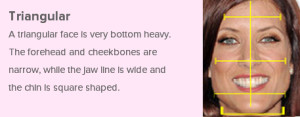
- Forehead and cheekbones are narrow.
- Your jawline is wider than your forehead.
- Your chin is square and/or flat in shape.
- Your face is widest at your jawline..
- Your cheekbones are straight and taper from your jaw to your forehead.
- Your forehead is narrow.
Diamond Face Shape
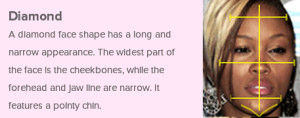
- Forehead and jawline are narrow.
- Your chin is noticeably pointed.
- Your jawline is long, narrow and tapers into a point.
- Cheekbones are wide and high.
- Your face is widest at your cheekbones.
Best Hairstyles:
- Side parts
- Chin-length or longer cuts
- Curtain bangs or side-swept fringe
- Textured lobs
- Styles with volume at the forehead
Styles to Avoid:
- Slicked-back styles
- Very tight updos
- Heavy, straight bangs
Oblong Face Shape
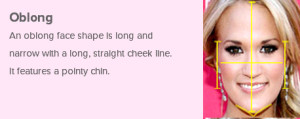
- Face is longer than it is wide.
- Your forehead and jawline are a similar width in appearance.
- Your cheek line and the sides of your face are straight.
- Your forehead is tall and wide and may be round at your hairline.
- Your face is widest at your forehead
Best Hairstyles: - Styles with volume on the sides
- Bangs to shorten the face visually
- Layered cuts with fullness
- Waves and curls
- Medium-length styles with body
Styles to Avoid: - Very long, straight styles without layers
- Center parts with no bangs
- Styles with too much height on top
Other Considerations
Hair Texture
Your natural hair texture plays a significant role in determining suitable styles:
- Fine Hair: Blunt cuts, layers focused near the ends, and shorter styles generally work best
- Thick Hair: Layers throughout to remove bulk and add movement
- Curly Hair: Longer lengths help weigh down curls; layers can add shape
- Straight Hair: Can handle precise geometric cuts and various lengths
Lifestyle Factors
Consider how much time you’re willing to spend on styling:
- Low-maintenance: Choose styles that work with your natural texture
- Medium effort: Styles that require basic blow-drying and occasional products
- High effort: Cuts that need regular styling, heat tools, and products
Age Considerations
As we age, face shapes can change slightly, and hair texture often becomes finer:
- 20s-30s: Most styles are workable; experiment freely
- 40s-50s: Consider softer layers around the face; slightly shorter styles often look more youthful
- 60+: Softer cuts with movement tend to be most flattering; avoid extremely long or severely short styles
Working with Your Stylist
To get the best results:
- Bring references: Photos of styles you like help communicate your vision
- Be realistic: Consider your hair type and daily styling routine
- Listen to suggestions: Professional stylists can offer valuable insights based on your unique features
- Be specific: Clearly communicate what you like and dislike about your current style
- Start conservatively: You can always go shorter or add more layers later
Beyond Face Shape
While face shape is important, other factors to consider include:
- Neck length: Shorter necks may benefit from hair that doesn’t fall at neck level
- Facial features: You might want to highlight your eyes or cheekbones
- Overall proportions: Your height and build can influence what looks balanced
- Personal style: The best haircut ultimately reflects your personality and comfort level
Understanding your face shape provides a helpful starting point in your hairstyle journey, but it’s just one factor among many. The perfect haircut balances face shape considerations with your hair texture, lifestyle needs, and personal preferences. Don’t be afraid to consult with professional stylists who can provide tailored recommendations based on your unique characteristics.
Remember that confidence is the ultimate accessory—when you feel good in your hairstyle, it shows!
